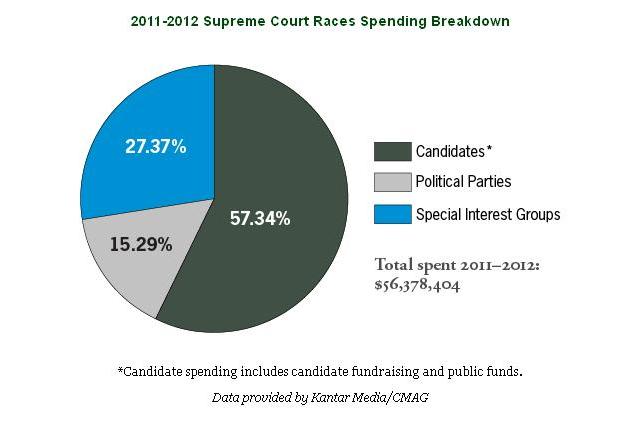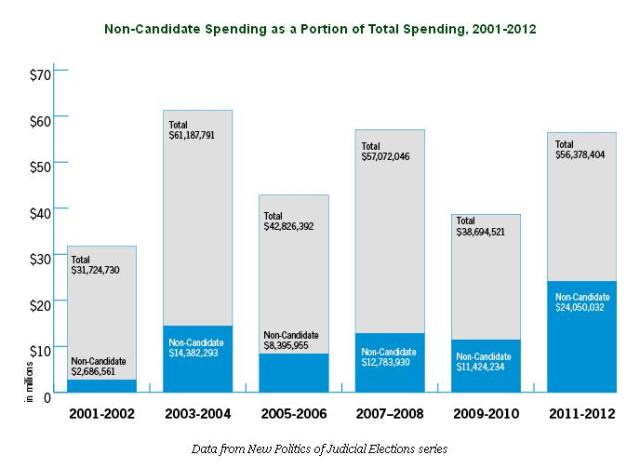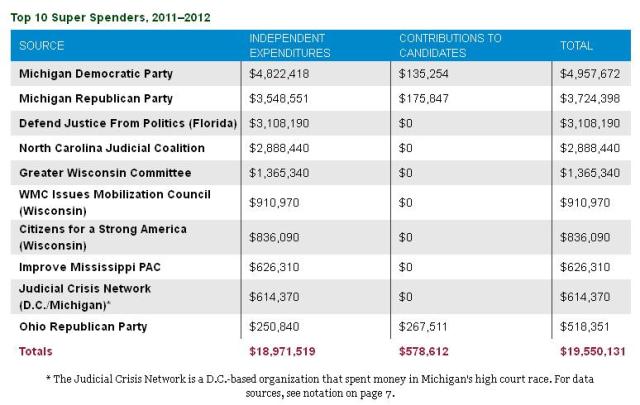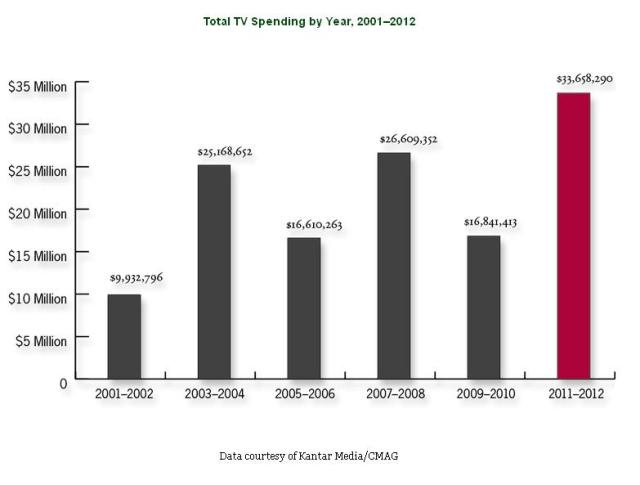In the first full election cycle since Citizens United, special interest groups and political parties spent an unprecedented $24.1 million on state court races in 2011–12 — an increase of over $11 million since 2007–08. This dramatic increase in independent spending fueled the costliest election cycle for TV spending in judicial election history, leading to nasty attack ads, and posing grave new threats to our fair and impartial courts.
“The New Politics of Judicial Elections, 2011–12” analyzes the prominent role of special interest money in state Supreme Court elections. In 2011–12, many of these races “seemed alarmingly indistinguishable from ordinary political campaigns—featuring everything from Super PACs and mudslinging attack ads to millions of dollars of candidate fundraising and independent spending.” The report documents how the “boundaries that keep money and political pressure from interfering with the rule of law have become increasingly blurred.” The report was written by Justice at Stake, the Brennan Center for Justice at NYU School of Law, and the National Institute on Money in State Politics.
Download the PDF | Read the Fact Sheet | Read the Poll | See the Charts | Watch the Ads | View on Scribd | Read Past New Politics Reports
Watch the Video
Introduction
In recent years, as the cost of judicial campaigns has soared, the boundaries that keep money and political pressure from interfering with the rule of law have become increasingly blurred.
Thirty-eight states conduct elections for their Supreme Courts, including partisan and nonpartisan contested elections and up-or-down judicial retention votes. During the 2011–12 election cycle, many of these judicial races seemed alarmingly indistinguishable from ordinary political campaigns—featuring everything from Super PACs and mudslinging attack ads to millions of dollars of candidate fundraising and independent spending.
Since 2000, The New Politics of Judicial Elections series has tracked the increased politicization and escalating spending in state judicial campaigns, as well as the growing role of special interest money. These trends continued in 2011–12, even as several new and troubling developments emerged.
- Television spending hit record highs: States saw record levels of spending on television advertising in high court races. The 2011–12 cycle saw $33.7 million in TV spending, far exceeding the previous two-year record of $26.6 million in 2007–08 ($28.5 million in inflation-adjusted terms). In 2012 alone, more than $29.7 million was spent to air TV ads, topping the previous single-year record of $24.4 million in 2004 ($29.3 million when adjusted for inflation). Negative advertisements aired in at least 10 states, including misleading ads that described candidates as being “sympathetic to rapists,” “volunteer[ing] to help free a terrorist,” and “protect[ing] . . .sex offenders.”
- Independent spending escalated: Citizens United v. FEC, 2010’s blockbuster Supreme Court decision that unleashed unlimited independent spending on elections, cast a long shadow on the 2011–12 judicial election cycle. Special-interest groups alone spent a record $15.4 million on television ads and other electioneering in high court races in 2011–12, accounting for more than 27 percent of the total amount spent on high court races. This spending was more than 50 percent higher than the previous record $9.8 million in independent spending by interest groups in 2003–04 ($11.8 million when adjusted for inflation), which made up 16 percent of total spending.
- National politics invaded judicial races: National groups better known for their efforts to influence presidential and congressional elections turned their sights on judicial contests in several states. Major spenders included the Republican State Leadership Committee in North Carolina, the National Rifle Association-linked Law Enforcement Alliance of America in Mississippi, the progressive advocacy group America Votes in Florida, and the conservative group Americans for Prosperity, financially supported by billionaire brothers Charles and David Koch, in Florida and North Carolina.
- Costly races continued around the country: Total estimated spending on judicial races in 2011–12 was $56.4 million, slightly lower than the total spending in the last presidential election cycle in 2007–08 ($57.1 million, or $60.7 million when adjusted for inflation). Twelve states saw more than $1 million of spending on high court races in 2011–12, similar to 2007–08, when spending surpassed $1 million in 11 states. Spending was concentrated among a few interest groups and political parties: the top 10 spenders were responsible for approximately $19.6 million of total spending in 2011–12, compared with just $12.3 million in 2007–08.
- Merit selection faced new challenges: In merit selection states, judges are appointed from a slate of qualified finalists identified by a nominating commission, and then typically stand for an up-or-down retention vote after subsequent terms. While retention races have historically been less politicized than contested elections, in 2012 two merit selection states, Florida and Iowa, saw prominent and politically charged challenges to sitting justices. These justices were ultimately retained, but only after costly battles. Several states also saw ballot measures in 2012 that would have injected new politicization into merit selection systems. These proposals were likewise rejected by voters.
The good news is that states retain powerful tools to resist the growing politicization of judicial races. Strong disclosure laws and recusal rules promote accountability and help ensure that special interests cannot buy justice. Public financing can provide judicial candidates with an alternative path to running a competitive race without needing to rely on contributions from lawyers and litigants seeking to influence judicial decision-making. Merit selection, meanwhile, is designed to ensure that judges are selected based on their qualifications and to help insulate them from political pressure (although in recent years concerns have emerged regarding the politicization of retention elections). Finally, voter guides and judicial performance evaluations give ordinary citizens the information they need to assess judges based on their experience and qualifications—and not on misleading attack ads. These commonsense measures can help ensure that citizens feel confident that their judges are accountable to the law and the Constitution, not to special interests.
 Charts
Charts
New Politics of Judicial Elections 2011–12
About the Authors
Justice at Stake is a nonpartisan campaign working to keep America’s courts fair and impartial. Justice at Stake and its 50-plus state and national partners work for reforms to keep politics and special interests out of the courtroom—so judges can protect our Constitution, our rights and the rule of law. Justice at Stake also educates Americans about the role of the courts, promotes diversity on the bench, and supports adequate resources for courts.
The Brennan Center for Justice at NYU School of Law is a nonpartisan law and policy institute that seeks to improve our systems of democracy and justice. The Center’s work ranges from voting rights to campaign finance reform, from racial justice in criminal law to Constitutional protection in the fight against terrorism. A singular institution—part think tank, part public interest law firm, part advocacy group, part communications hub—the Brennan Center seeks meaningful, measurable change in the systems by which our nation is governed.
The National Institute on Money in State Politics collects, publishes, and analyzes data on campaign money in state elections. The database dates back to the 1990 election cycle for some states and is comprehensive for all 50 states since the 1999–2000 election cycle. The Institute has compiled a 50-state summary of state supreme court contribution data from 1989 through the present, as well as complete, detailed databases of campaign contributions for all state high-court judicial races beginning with the 2000 elections.




